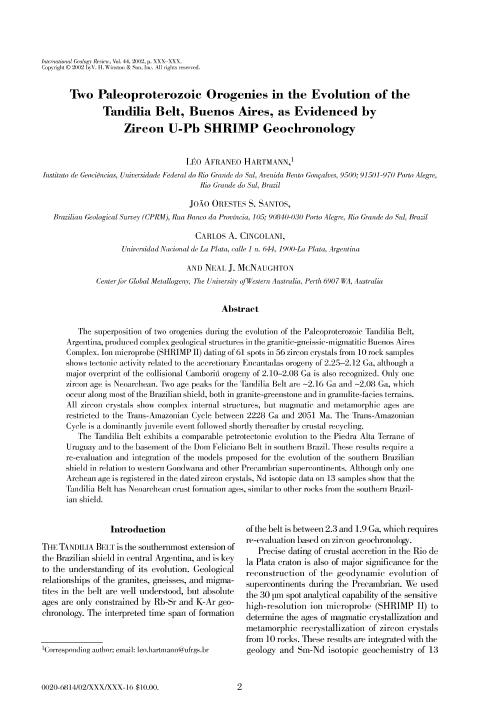Mostrar el registro sencillo del ítem
dc.contributor.author
Hartmann, Léo Afraneo
dc.contributor.author
Santos, João Orestes

dc.contributor.author
Cingolani, Carlos Alberto

dc.contributor.author
McNaughton, Neal J.
dc.date.available
2019-03-22T20:36:43Z
dc.date.issued
2002-12
dc.identifier.citation
Hartmann, Léo Afraneo; Santos, João Orestes; Cingolani, Carlos Alberto; McNaughton, Neal J.; Two paleoproterozoic orogenies in the evolution of the tandilia belt, buenos aires, as evidenced by zircon u-pb shrimp geochronology; Taylor ; International Geology Review; 44; 6; 12-2002; 528-543
dc.identifier.issn
0020-6814
dc.identifier.uri
http://hdl.handle.net/11336/72361
dc.description.abstract
The superposition of two orogenies during the evolution of the Paleoproterozoic Tandilia Belt, Argentina, produced complex geological structures in the granitic-gneissic-migmatitic Buenos Aires Complex. Ion microprobe (SHRIMP II) dating of 61 spots in 56 zircon crystals from 10 rock samples shows tectonic activity related to the accretionary Encantadas orogeny of 2.25-2.12 Ga, although a major overprint of the collisional Camboriú orogeny of 2.10-2.08 Ga is also recognized. Only one zircon age is Neoarchean. Two age peaks for the Tandilia Belt are ~2.16 Ga and ~2.08 Ga, which occur along most of the Brazilian shield, both in granite-greenstone and in granulite-facies terrains. All zircon crystals show complex internal structures, but magmatic and metamorphic ages are restricted to the Trans-Amazonian Cycle between 2234 Ga and 2065 Ma. The Trans-Amazonian Cycle is a dominantly juvenile event followed shortly thereafter by crustal recycling. The Tandilia Belt exhibits a comparable petrotectonic evolution to the Piedra Alta Terrane of Uruguay and to the basement of the Dom Feliciano Belt in southern Brazil. These results require a re-evaluation and integration of the models proposed for the evolution of the southern Brazilian shield in relation to western Gondwana and other Precambrian supercontinents. Although only one Archean age is registered in the dated zircon crystals, Nd isotopic data on 13 samples show that the Tandilia Belt has Neoarchean crust formation ages, similar to other rocks from the southern Brazilian shield. © 2002 Taylor & Francis Group, LLC.
dc.format
application/pdf
dc.language.iso
eng
dc.publisher
Taylor

dc.rights
info:eu-repo/semantics/openAccess
dc.rights.uri
https://creativecommons.org/licenses/by-nc-sa/2.5/ar/
dc.subject.classification
Meteorología y Ciencias Atmosféricas

dc.subject.classification
Ciencias de la Tierra y relacionadas con el Medio Ambiente

dc.subject.classification
CIENCIAS NATURALES Y EXACTAS

dc.title
Two paleoproterozoic orogenies in the evolution of the tandilia belt, buenos aires, as evidenced by zircon u-pb shrimp geochronology
dc.type
info:eu-repo/semantics/article
dc.type
info:ar-repo/semantics/artículo
dc.type
info:eu-repo/semantics/publishedVersion
dc.date.updated
2019-03-18T14:43:52Z
dc.journal.volume
44
dc.journal.number
6
dc.journal.pagination
528-543
dc.journal.pais
Estados Unidos

dc.journal.ciudad
Silver Spring
dc.description.fil
Fil: Hartmann, Léo Afraneo. Universidade Federal do Rio Grande do Sul; Brasil
dc.description.fil
Fil: Santos, João Orestes. Brazilian Geological Survey; Brasil
dc.description.fil
Fil: Cingolani, Carlos Alberto. Universidad Nacional de La Plata; Argentina
dc.description.fil
Fil: McNaughton, Neal J.. University of Western Australia; Australia
dc.journal.title
International Geology Review

dc.relation.alternativeid
info:eu-repo/semantics/altIdentifier/url/https://www.tandfonline.com/doi/abs/10.2747/0020-6814.44.6.528
dc.relation.alternativeid
info:eu-repo/semantics/altIdentifier/doi/https://doi.org/10.2747/0020-6814.44.6.528
Archivos asociados
